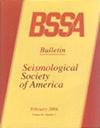Crustal Imaging with Noisy Teleseismic Receiver Functions Using Sparse Radon Transforms
IF 2.9
3区 地球科学
Q2 GEOCHEMISTRY & GEOPHYSICS
引用次数: 0
Abstract
The receiver function (RF) is a widely used crustal imaging technique. In principle, it assumes relatively noise-free traces that can be used to target receiver-side structures following source deconvolution. In practice, however, mode conversions and reflections may be severely degraded by noisy conditions, hampering robust estimation of crustal parameters. In this study, we use a sparsity-promoting Radon transform to decompose the observed RF traces into their wavefield contributions, that is, direct conversions, multiples, and incoherent noise. By applying a crustal mask on the Radon-transformed RF, we obtain noise-free RF traces with only Moho conversions and reflections. We demonstrate, using a synthetic experiment and a real-data example from the Sierra Nevada, that our approach can effectively denoise the RFs and extract the underlying Moho signals. This greatly improves the robustness of crustal structure recovery as exemplified by subsequent H−κ stacking. We further demonstrate, using a station sitting on loose sediments in the Upper Mississippi embayment, that a combination of our approach and frequency-domain filtering can significantly improve crustal imaging in reverberant settings. In the presence of complex crustal structures, for example, dipping Moho, intracrustal layers, and crustal anisotropy, we recommend caution when applying our proposed approach due to the difficulty of interpreting a possibly more complicated Radon image. We expect that our technique will enable high-resolution crustal imaging and inspire more applications of Radon transforms in seismic signal processing.使用稀疏拉顿变换利用噪声远震接收器函数进行地壳成像
接收函数(RF)是一种广泛使用的地壳成像技术。原则上,它假定相对无噪声的轨迹,可在源解卷积后用于锁定接收端结构。但在实际应用中,模式转换和反射可能会因噪声条件而严重衰减,从而影响地壳参数的稳健估算。在本研究中,我们使用稀疏性促进拉顿变换将观测到的射频轨迹分解为波场贡献,即直接转换、倍频和非相干噪声。通过在拉顿变换的射频上应用地壳掩模,我们获得了仅有莫霍转换和反射的无噪声射频轨迹。我们利用内华达山脉的一个合成实验和一个真实数据示例证明,我们的方法可以有效地对射频进行去噪,并提取潜在的莫霍信号。这极大地提高了地壳结构恢复的稳健性,随后的 H-κ 叠加就是例证。我们还利用密西西比河上海湾松散沉积物上的一个站点进一步证明,我们的方法与频域滤波相结合,可以显著改善混响环境下的地壳成像。如果存在复杂的地壳结构,如倾斜的莫霍面、地壳内层和地壳各向异性,我们建议在应用我们提出的方法时要谨慎,因为很难解释可能更加复杂的拉顿图像。我们期待我们的技术能够实现高分辨率地壳成像,并激发 Radon 变换在地震信号处理中的更多应用。
本文章由计算机程序翻译,如有差异,请以英文原文为准。
求助全文
约1分钟内获得全文
求助全文
来源期刊

Bulletin of the Seismological Society of America
地学-地球化学与地球物理
CiteScore
5.80
自引率
13.30%
发文量
140
审稿时长
3 months
期刊介绍:
The Bulletin of the Seismological Society of America, commonly referred to as BSSA, (ISSN 0037-1106) is the premier journal of advanced research in earthquake seismology and related disciplines. It first appeared in 1911 and became a bimonthly in 1963. Each issue is composed of scientific papers on the various aspects of seismology, including investigation of specific earthquakes, theoretical and observational studies of seismic waves, inverse methods for determining the structure of the Earth or the dynamics of the earthquake source, seismometry, earthquake hazard and risk estimation, seismotectonics, and earthquake engineering. Special issues focus on important earthquakes or rapidly changing topics in seismology. BSSA is published by the Seismological Society of America.
 求助内容:
求助内容: 应助结果提醒方式:
应助结果提醒方式:


